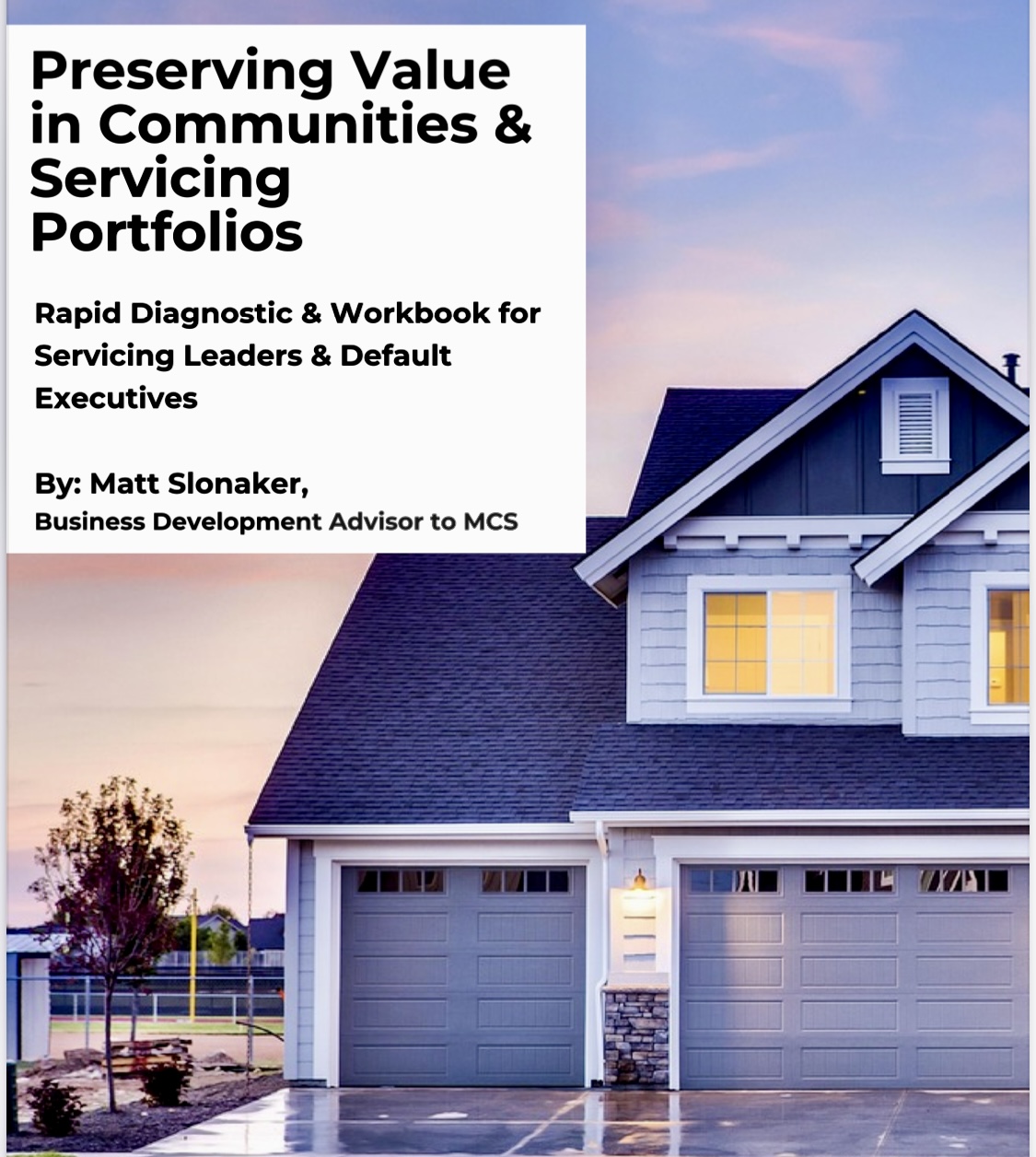The Latest in Prop Pres: Managing Risks
Apr 03, 2025
The Latest Trends and Pains in Property Preservation: Navigating a Shifting Landscape

Property preservation remains a critical component of the mortgage servicing industry, ensuring that vacant or distressed properties retain their value while complying with an ever-evolving web of regulations. As we move into the second quarter of 25, the challenges and opportunities in this space are more pronounced than ever. Industry veterans, like Matt Slonaker, Business Development Advisor to MCS and Founder of M. Allen LLC, bring decades of experience to the table, shedding light on the latest trends and persistent pains faced by loan servicing leaders and default executives. In this blog, we’ll explore these dynamics, drawing from real-world insights and innovative solutions shaping the future of property preservation.
Emerging Trends in Property Preservation
- Heightened Regulatory Scrutiny
Regulatory bodies are tightening their grip on property preservation practices, with a focus on compliance with FHA, HOA, and local code requirements. The push for transparency and accountability has led to more frequent audits and stricter penalties for non-compliance. Forward-thinking companies are adopting proactive strategies, such as centralized compliance oversight and automated registration systems, to stay ahead of these changes. This trend reflects a broader industry shift toward risk mitigation in an uncertain economic climate. - Technology-Driven Transparency
The rise of advanced technology platforms is revolutionizing how preservation tasks are managed. Real-time tracking, mobile access, and comprehensive documentation—like the 9 million+ before-and-after photos provided monthly by MCS—are becoming standard. These tools not only enhance visibility for servicers but also empower them to make data-driven decisions, reducing errors and improving efficiency. The integration of configurable software tailored to specific operational needs is a game-changer, particularly for organizations scaling nationwide. - Hybrid Service Models
A notable trend is the adoption of hybrid service models that combine in-house teams with extensive networks of certified vendors. Companies like MCS leverage self-performing crews alongside 10,000+ vetted partners to handle millions of properties annually. This approach balances control and scalability, allowing servicers to respond swiftly to peak demand—such as post-disaster surges—while maintaining quality standards. - Focus on Scalability and Market Expansion
As mortgage servicers eye growth into new regions, the ability to adapt preservation operations to diverse markets is paramount. The 2024 acquisition of Five Brothers by MCS exemplifies this trend, bolstering nationwide reach and providing a blueprint for seamless expansion. Servicers are increasingly seeking partners with pre-vetted vendor networks and local compliance expertise to mitigate risks in uncharted territories. - Sustainability and Asset Value Protection
With economic downturns looming, preserving asset value during distress is a top priority. Best practices now emphasize high-impact actions like securing properties and winterization, supported by predictive cost forecasting and integrated workflows. This trend underscores a strategic shift from reactive maintenance to proactive asset management.
Persistent Pains in Property Preservation
Despite these advancements, loan servicing executives continue to grapple with significant challenges that can derail operations and profitability.
- Compliance Headaches
Navigating the labyrinth of FHA, HOA, and local codes remains a major pain point. Frequent regulatory changes often catch teams off-guard, leading to last-minute adjustments, fines, or operational disruptions. Without streamlined processes, compliance can become a reactive burden rather than a strategic advantage. - Vendor Inconsistency
Reliance on a fragmented vendor ecosystem—sometimes exceeding 10+ providers—creates coordination nightmares. Delays in tasks like winterization or inspections, coupled with inconsistent quality and scalability issues during peak demand, erode trust and inflate costs. Complaints about incomplete work or poor documentation further compound the problem. - Operational Inefficiencies
Slow turnarounds, siloed workflows, and rework are persistent drags on efficiency. Standard preservation tasks, such as securing a vacant property, can take days or even weeks, delaying loan resolutions and increasing financial exposure. The lack of integration between preservation and broader servicing operations exacerbates these delays. - Cost Unpredictability
Unforeseen expenses, driven by vendor-related issues or preservation errors, destabilize budgets. When oversight and rework consume over 20% of a budget, profitability takes a hit. This financial pressure is particularly acute during economic uncertainty, where every dollar counts. - Growth and Adaptability Challenges
Expanding into new markets or responding to unexpected events—like natural disasters—tests operational resilience. Many organizations lack the agility to adapt within days or the confidence to maintain asset value during downturns, leaving them vulnerable to market shifts.
The Path Forward: Leveraging Expertise and Innovation
The good news is that these pains are addressable with the right strategies and partnerships. Centralized compliance oversight, rigorous vendor vetting, and modern technology can transform challenges into opportunities. Companies like MCS, with over 35 years of experience and a track record of serving top-tier clients like KinderCare and national mortgage servicers, are leading the charge. Their hybrid model, backed by state-of-the-art platforms and a focus on transparency, offers a blueprint for success.
For instance, MCS’s ability to deliver on-time maintenance, supported by real-time updates and extensive photo documentation, addresses the twin needs of speed and quality. Their 2024 debt refinancing of $112 million further signals financial strength, enabling scalable growth to meet evolving market demands. Testimonials from industry leaders highlight MCS’s customer-centric approach and steadfast reliability, reinforcing its position as a trusted partner.
Preview: Key Assessment Questions and MCS Solutions
To help loan servicing executives evaluate their property preservation capabilities, Matt Slonaker’s diagnostic tool offers a structured assessment. Here’s a preview of key questions, drawn from the workbook, alongside how MCS addresses these gaps:
- Compliance & Regulatory Management
Q1: How confident are you that your property preservation efforts fully comply with FHA, HOA, and local code requirements?
MCS provides tailored registration, inspections, and deep industry knowledge to exceed regulatory standards, reducing compliance risks. - Vendor Performance & Reliability
Q4: How would you rate the consistency of your current vendors in meeting deadlines for preservation tasks?
With a robust network of 10,000+ certified partners, MCS ensures on-time delivery and scalability, even during peak demand. - Operational Efficiency
Q8: How long does it typically take to complete a standard property preservation task?
MCS targets turnarounds within 48 hours through optimized workflows, minimizing delays and rework. - Technology & Transparency
Q11: How much visibility do you have into the status of preservation work in real-time?
MCS’s state-of-the-art platforms offer complete visibility with 9 million+ monthly photos, enhancing oversight and decision-making. - Cost & Financial Impact
Q14: How predictable are your property preservation costs month-to-month?
MCS’s flexible technology and cost estimators enable accurate forecasting, stabilizing budgets. - Growth & Market Adaptability
Q17: How prepared is your team to handle preservation needs in new markets or regions?
With nationwide coverage and the Five Brothers acquisition, MCS provides a proven playbook for expansion.
This diagnostic, paired with a consultation, can pinpoint specific weaknesses and chart a path to transformation. To explore how MCS can address your unique challenges, visit mcs360.com or contact Matt Slonaker at [email protected]to schedule a call.
Conclusion
The property preservation landscape is at a crossroads, with trends like technology integration and hybrid models offering hope, while pains like compliance and vendor issues persist. By leveraging expert partnerships and innovative tools, loan servicing leaders can turn these challenges into competitive advantages. As the industry evolves, MCS stands ready to shine a light on the path forward—ensuring communities thrive and portfolios prosper.
